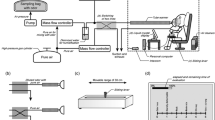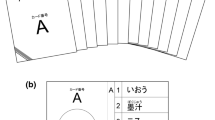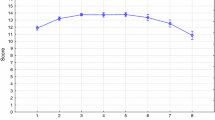Abstract
Previous research suggests that the variability in odor detectability is large in the elderly population. Compared to young adults, most elderly demonstrate poor detectability although some show normal ability. To shed light on why there is this discrepancy among the elderly, absolute detection thresholds for pyridine odor were determined by the method of constant stimuli. Young adults (20–24 years) were compared with elderly (77–87 years) who were “successfully aged” with respect to medical health and cognitive ability. The results showed that these elderly and young adults had very similar mean detection thresholds for pyridine (105 and 100 ppb, respectively) and psychometric detection functions (identical slopes with increasing pyridine concentration). These results imply that deficits in odor detectability may not be inevitable to the aging individual and that factors secondary to aging, such as poor medical health status and cognitive decline, may contribute to deficits in odor detectability in normal aging.


Similar content being viewed by others
References
AFS, Arbetarskyddsstyrelsens författningssamling (1989) Hygieniska gränsvärden, AFS 1989:4. Liber, Stockholm [In Swedish]
Bahtnagar KP, Kennedy RC, Baron G, Greenberg RA (1987) Number of mitral cells and the bulb volume in the aging human olfactory bulb: a quantitative morphological study. Annatom Rec 218:73–87
Benton A, Hamsher KS (1978) Multilingua aphasis examination. University Hospital of Iowa, Department of Neurology, Iowa City
Berglund B, Berglund U, Johansson I, Lindvall T (1986a) Research equipment for air quality studies of nonindustrial environments. Environ Int 8:189–194
Berglund B, Berglund U, Lindvall T (1986b) Theory and methods for odor evaluation. Experientia 42:280–287
Berglund B, Högman L, Johansson I (1988a) Reliability of odor measurements near threshold. Reports from the Department of Psychology, University of Stockholm, No. 682.
Berglund B, Högman L, Meijers L (1988b) A combined scaling and detection method for odor evaluation at low concentrations. Reports from the Department of Psychology, University of Stockholm, No. 685.
Boyle E, Aparicio AM, Kaye J, Acker M (1975) Auditory and visual memory losses in aging populations. J Am Geritric Soc 23:284–286
Brämerson A, Johansson L, Ek L, Nordin S, Bende M (2004) Prevalence of olfactory dysfunction: the Skövde population-based study. Laryngoscope 114:733–737
Cain WS, Gent JF (1991) Olfactory sensitivity: reliability, generality, and association with aging. J Exp Psychol Human Perc Performance 17:382–391
Cain WS, Stevens JC (1989) Uniformity of olfactory loss in aging. Ann NY Acad Sci 561:29–38
Cain WS, Reid F, Stevens JC (1990) Missing ingredients: aging and the discrimination of flavor. J Nutr Elderly 9:3–15
Cain WS, Stevens JC, Nickou CM, Giles A, Johnston I, Garcia-Medina MR (1995) Life-span development of odor identification, learning, and olfactory sensitivity. Percept 24:1457–1472
Cain WS, de Wijk RA, Nordin S, Nordin M (2008) Independence of odor quality and absolute sensitivity in a study of aging. Chem Percept 1:24–33
Cerf-Ducastel B, Murphy C (2003) FMRI brain activation in response to odors is reduced in primary olfactory areas of elderly subjects. Brain Res 986:39–53
Cowart BJ (1989) Relationships between taste and smell across the adult life span. Ann NY Acad Sci 561:39–55
Doty RL (2003) Odor perception in degenerative diseases. In: Doty RL (ed) Handbook of olfaction and gustation. Marcel Dekker, New York, pp 479–501
Doty RL, Shamam P, Applebaum SL, Giberson R, Siksorski L, Rosenberg L (1984) Smell identification ability: changes with age. Sci 226:1441–1443
Duffy VB, Backstrand J, Ferris A (1995) Olfactory dysfunction and related nutritional risk in free-living, elderly women. J Am Diet Ass 95:879–884
Duffy V, Cain WS, Ferris A (1999) Measurement of sensitivity to olfactory flavor: application in a study of aging and dentures. Chem Senses 24:671–677
Engen T (1971) Psychophysics. I. Discrimination and detection. In: Kling JW, Riggs LA (eds) Woodworth & Schlosberg’s experimental psychology. Holt, New York, pp 11–46
Engen T (1982) The perception of odors. Academic Press, New York
Engen T (1991) Odor sensation and memory. Praeger, New York
Folstein MF, Folstein SE, McHugh PR (1975) “Mini-Mental State”: a practical method for grading the cognitive state of patients for the clinician. J Psychiatr Res 12:189–198
Gescheider GA (1997) Psychophysics: the fundamentals. Erlbaum, Mahwah
Havighurst RJ (1963) Successful aging. In: Williams RH, Tibbits C, Donahue W (eds) Processes of aging, vol 1. Atherton, New York, pp 299–320
Hedner M, Larsson M, Arnold N, Zucco GM, Hummel T (2010) Cognitive factors in odor detection, odor discrimination, and odor identification tasks. J Clin Exp Neuropsychol 32:1062–1067
Hummel T, Sekinger B, Wolf SR, Pauli E, Kobal G (1997) 'Sniffin' sticks': olfactory performance assessed by the combined testing of odor identification, odor discrimination and olfactory threshold. Chem Senses 22:39–52
Hummel T, Barz S, Pauli E, Kobal G (1998) Chemosensory event-related potentials change as a function of age. Electroencephalogr Clin Neurophysiol 108:208–217
Iregren A, Gamberale F, Kjellberg A (1996) SPES: a psychological test system to diagnose environmental hazards. Neurotoxicol Teratol 18:485–491
Kaneda H, Maeshima K, Goto N, Kobayakawa T, Ayabe-Kanamura S, Saito S (2000) Decline in taste and odor discrimination abilities with age, and relationship between gustation and olfaction. Chem Senses 25:331–337
Kaplan E, Goodglass H, Weintraub S (1978) The Boston naming test. Lea, Philadelphia
Kovács T (2004) Mechanisms of olfactory dysfunction in aging and neurodegenerative disorders. Ageing Res Rev 3:215–232
Larsson M, Bäckman L (1993) Semantic activation and episodic odor recognition in young and older adults. Psychol Aging 8:582–588
Larsson M, Bäckman L (1997) Age-related differences in episodic odour recognition: the role of access to specific odour names. Memory 5:361–378
Larsson M, Nilsson L-G, Olofsson J, Nordin S (2004) Demographic and cognitive predictors of cued odor identification: evidence from a population-based study. Chem Senses 29:547–554
Lezak MD (1983) Neuropsychological assessment. Oxford University Press, New York
Lines CR, Dawson C, Presto GC, Reich S, Foster C, Traub M (1991) Memory and attention in patients with senile dementia of the Alzheimer type and in normal elderly subjects. J Clin Exp Neuropsychol 13:691–702
Milner B (1971) Interhemispheric differences in the location of psychological processes in man. Br Med Bull 27:272–277
Murphy C (1985) Cognitive and chemosensory influences on age-related changes in the ability to identify blended foods. J Gerontol 40:47–52
Murphy C, Cain WS, Gilmore MM, Skinner RB (1991) Sensory and semantic factors in recognition memory for odors and graphic stimuli: elderly versus young persons. Am J Psychol 104:161–192
Murphy C, Nordin S, de Wijk RA, Cain WS, Polich J (1994) Olfactory evoked potentials: assessment of young and elderly, and comparison to psychophysical threshold. Chem Senses 19:47–56
Murphy C, Nordin S, Acosta L (1997) Odor learning, recall, and recognition memory in young and elderly adults. Neuropsychol 11:126–137
Murphy C, Morgan CD, Geisler MW, Wetter S, Covington JW, Madowitz MD, Nordin S, Polich JM (2000) Olfactory event-related potentials and aging: normative data. Int J Psychophysiol 36:133–145
Murphy C, Schubert CR, Cruickshanks KJ, Klein BE, Klein R, Nondahl DM (2002) Prevalence of olfactory impairment in older adults. J Am Med Ass 288:2307–2312
Murphy C, Doty RL, Duncan HJ (2003) Clinical disorders of olfaction. In: Doty RL (ed) Handbook of olfaction and gustation. Marcel Dekker, New York, pp 461–478
Rawson NE, Gomez G, Cowart B, Restrepo D (1998) The use of olfactory receptor neurons (ORNs) from biopsies to study changes in aging and neurodegenerative disease. Ann NY Acad Sci 855:701–707
Rowe JW, Kahn RL (1987) Human aging: usual and successful. Sci 237:143–149
Saxton J, Ratcliff G, Munro CA, Coffey EC, Becker JT, Fried L, Kuller L (2000) Normative data on the Boston naming test and two equivalent 30-item short forms. Clin Neuropsychol 14:526–534
Schemper T, Voss S, Cain WS (1981) Odor identification in young and elderly persons: sensory and cognitive limitations. J Gerontol 36:446–452
Schiffman SS, Leffingwell JC (1981) Perception of odors of simple pyrazines by young and elderly subjects: a multidimensional analysis. Pharmacol Biochem Behav 14:787–798
Schiffman S, Pasternak M (1979) Decreased discrimination of food odors in the elderly. J Gerontol 34:73–79
Schiffman SS, Moss J, Erickson RP (1976) Thresholds of food odors in the elderly. Exp Aging Res 2:389–398
Ship JA, Weiffenbach JM (1993) Age, gender, medical treatment, and medication effects on smell identification. J Gerontol 48:M26–M32
Smith PJ, Langolf GD, Goldberg J (1983) Effects of occupational exposure to elemental mercury on short-term memory. Br J Ind Med 40:413–419
Stevens JC, Cain WS (1985) Age-related deficiency in the perceived strength of six odorants. Chem Senses 10:517–529
Stevens JC, Cain WS (1986) Smelling via the mouth: effect of aging. Percet Psychophys 40:142–146
Stevens JC, Cain WS (1987) Old-age deficits in the sense of smell as gauged by thresholds, magnitude matching, and odor identification. Psychol Aging 2:36–42
Stevens JC, Cain WS (1993) Changes in taste and flavor in aging. Crit Rev Food Sci Nutr 33:27–37
Stevens JC, Dadarwala AD (1993) Variability of olfactory threshold and its role in assessment of aging. Percept Psychophys 54:296–302
Stevens DA, Lawless HT (1981) Age-related changes in flavor perception. Appetite 2:127–136
Stevens JC, Cain WS, Weinstein DE (1987) Aging impairs the ability to detect gas odor. Fire Technol 23:198–204
Stevens JC, Cain WS, Schiet FT, Oatley MW (1989) Olfactory adaptation and recovery in old age. Percept 18:265–276
Swedish Council for Medical Research (1995) Demenssjukdom: diagnostik, tidig behandling och anhörigas insatser. Medicinska forskningsrådet, Stockholm [In Swedish].
Tate RB, Lah L, Cuddy TE (2003) Definition of successful aging by elderly Canadian males: the Manitoba follow-up study. Gerontologist 43:735–744
Van Toller S, Dodd GH (1987) Presbyosmia and olfactory compensation for the elderly. Br J Clin Pract 41:725–728
Wahlund L-O, Almkvist O, Basun H, Julin P (1996) MRI in successful aging, a 5-year follow-up study from the eighth to ninth decade of life. Magn Res Imaging 14:601–608
Wang J, Eslinger PJ, Smith MB, Yang QX (2005) Functional magnetic resonance imaging study of human olfaction and normal aging. J Gerontol Biol Sci Med Sci 60:510–514
Wechsler D (1945) A standardized memory scale for clinical use. J Psychol 19:87–95
Wechsler D (1949) Wechsler intelligence scale for children: manual. The Psychological Corporation, New York
Wechsler D (1981) WAIS-R: manual. The Psychological Corporation, New York
Williams RH, Wirths CG (1965) Lives through the years: styles of life and successful aging. Atherton, New York
Wysocki CJ, Gilbert AN (1989) National geographic smell survey: effects of age are heterogenous. Ann NY Acad Sci 561:12–28
Acknowledgements
This research was sponsored by grants from The Swedish Research Council for Environment, Agricultural Sciences and Spatial Planning (FORMAS). We are indebted to Professor Lars-Olof Wahlund for performing medical examinations and to Ms. Jocelyne Ängeslevä and Mr. Armin Guhl for experimental and technical assistance.
Author information
Authors and Affiliations
Corresponding author
Rights and permissions
About this article
Cite this article
Nordin, S., Almkvist, O. & Berglund, B. Is Loss in Odor Sensitivity Inevitable to the Aging Individual? A Study of “Successfully Aged” Elderly. Chem. Percept. 5, 188–196 (2012). https://doi.org/10.1007/s12078-011-9102-8
Received:
Accepted:
Published:
Issue Date:
DOI: https://doi.org/10.1007/s12078-011-9102-8




